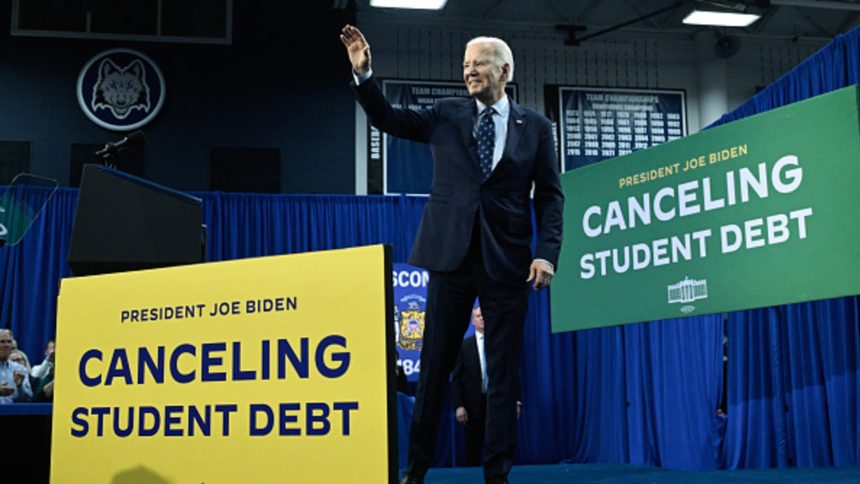Mishima Hughson filed for bankruptcy in December, joining the ranks of hundreds of thousands of Americans who undergo the process each year.
Along the way, the Roanoke, Virginia, resident also joined a much smaller group: Those who have managed to get their federal student loans erased in court. The U.S. Department of Education found that Hughson was no longer responsible for her $158,182 debt.
“I thought it was a joke,” Hughson, 58, said. “I was shocked.”
For decades, borrowers have found it next to impossible to walk away from their federal student debt in bankruptcy. Amid concerns that young people would try to ditch their obligations, policymakers made the bar for the discharge of student debt in court particularly high.
Some people needed to prove a “certainty of hopelessness,” and government lawyers battled most of the requests. Between 2011 and 2019, more than 99.8% of borrowers who filed for bankruptcy did not get their student loans discharged, U.S. lawmakers recently pointed out.
More from Personal Finance:
Mega backdoor Roth conversions can be a ‘no brainer’ for higher earners, expert says
Why a five-day return to office is unlikely, Stanford economist says
Here’s how ‘spaving’ could hurt your finances
That’s now changing.
In the fall of 2022, the U.S. Department of Education and the U.S. Department of Justice jointly released updated bankruptcy guidelines aimed at making the process for student loan borrowers less arduous. The Biden administration’s updated policy now treats student loans more like other types of debt in bankruptcy court, experts say.
“While the government used to fight discharge aggressively in almost every case, there is now a policy to agree when the borrower can show financial need and a history of good faith efforts to pay the loans,” said Latife Neu, a bankruptcy lawyer in Seattle.
“I’ve helped several people take advantage of the expanded ability,” Neu said.
Malissa Giles, the bankruptcy attorney who represented Hughson in Virginia, said she has helped several other borrowers get their student debt cleared under the Biden administration’s new policy. Collectively, those clients have received more than $1.25 million in relief.
“We have discharged student loans as low as $6,500 for debtors with super minimal income, and as high as $203,983,” Giles said.
Consumer advocates say that strong bankruptcy protections are essential to a fair lending system.
“If a lender knows that they are likely to lose a loan through bankruptcy discharge, they are more likely to adopt borrower-friendly policies, such as compromising with borrowers who face severe financial challenges,” said higher education expert Mark Kantrowitz.
‘I was not realistic about how little teachers made’
After graduating college in the 1990s with around $35,500 in student debt, Hughson went on to become a public school teacher in Virginia. Her salary began at around $30,000, and never rose above $50,000 in her over 10-year teaching career.
“You have a false expectancy that when you graduate you’ll land this amazing job, and you’ll be able to pay that debt back,” Hughson said. “But I was not realistic about how little teachers made.”
Hughson was also raising two children at the time, and couldn’t afford her monthly student loan bill.
“I put in for as many deferments as I could,” she said.
When she ran out of ways to postpone her payments, she fell behind and the U.S. Department of Education began garnishing her wages. The government has extraordinary collection powers on federal debts and, in addition to borrowers’ paychecks, it can also seize their tax refunds and Social Security retirement benefits.
“Aggressive collection methods for recovering defaulted student loans, such as wage garnishment, reduce the amount of money a borrower has to pay for basic necessities, such as housing, food and medical care,” Kantrowitz said. “They may be forced to rely on credit cards and other forms of debt to pay for basic living expenses.”
Indeed, Hughson’s financial situation only worsened after the garnishment. She used her credit cards to pay her bills, and eventually had a balance of more than $30,000 across her cards.
She left teaching in her 40s, hoping that she could earn more doing something else. She worked different jobs, including one helping adults with learning disabilities.
Although her earnings improved somewhat, her debt swallowed up most of what she made. Over the decades, her student loan balance swelled to over $150,000.
After she got paid and directed cash to her mushrooming credit card balances, she was left with just around $100 for that pay period.
“I could see that it was a never-ending cycle,” she said.
Last year, she decided to finally file for bankruptcy.
“I was in a hole I couldn’t dig myself out of,” Hughson said. “And now I’m free.”
Read the full article here




